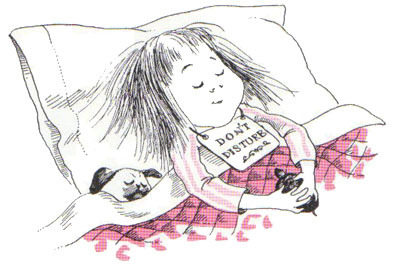By the time I had discovered Eloise (there is only one, you know), I was already well on my way to becoming Eloise – if I wasn’t already. By that time, I had already begun moving away from children’s books and into actual literature. My older brother had already read J. D. Salinger’s The Catcher In the Rye by the age of 7; and I took quite a few of my early reading cues from him – to give you some idea of the track I was on. (I didn’t read Catcher myself until I was about 12, at which point I was already up to my eyeballs in “phonies”; so it wasn’t quite the eye-opener it was for my brother or many of my peers.) I’d already had Madeline, Peter Pan, The Wizard of Oz, et seq.; the E. B. White crew of Charlotte, Wilbur, and Stuart Little; Lewis Carroll’s Alice; Dr. Seuss in every metamorphosis available from The Cat in the Hat to the Grinch; the odd bit of James Thurber and Roald Dahl and a smattering of Grimm and Andersen fairy tales; and about a thousand Little Golden Books that were sometimes consumed before we exited the supermarket where they were purchased.
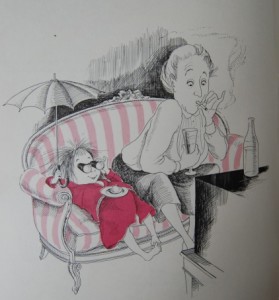 My parents could not have been more relieved since I developed a mania for almost anything that appeared in a series. (I didn’t discover Carroll’s Through the Looking Glass until I was almost 12, either – which practically induced a delayed spasm of FMO at the time.) My parents never picked up an Eloise book for me (and it would have been only for me, since my brother would have had little interest in playing out what would have clearly been my own fantasy, already veering dangerously close to reality). In retrospect, I think this was wise. Bear in mind that the original subtitle for Eloise (which I don’t think you see on later printings) was “A Book for Precocious Grown-Ups.” Which it sort of was. I was nowhere close to ‘grown-up’ (and sometimes wonder if I ever will be) – but precocious? I wouldn’t have even known what the word meant at five or six; but by that age I already knew who Kay Thompson and D.D. Ryan were, had already been to the Plaza (at least once anyway), had developed a taste for all things French and high-fashion, was passionate about the Metropolitan Opera (and Museum) and the New York Philharmonic, and thought a New York hotel (almost any New York hotel) might be just about the perfect place for a six year-old to live. This was all disturbing enough for my parents. So of course they had to keep Eloise from me.
My parents could not have been more relieved since I developed a mania for almost anything that appeared in a series. (I didn’t discover Carroll’s Through the Looking Glass until I was almost 12, either – which practically induced a delayed spasm of FMO at the time.) My parents never picked up an Eloise book for me (and it would have been only for me, since my brother would have had little interest in playing out what would have clearly been my own fantasy, already veering dangerously close to reality). In retrospect, I think this was wise. Bear in mind that the original subtitle for Eloise (which I don’t think you see on later printings) was “A Book for Precocious Grown-Ups.” Which it sort of was. I was nowhere close to ‘grown-up’ (and sometimes wonder if I ever will be) – but precocious? I wouldn’t have even known what the word meant at five or six; but by that age I already knew who Kay Thompson and D.D. Ryan were, had already been to the Plaza (at least once anyway), had developed a taste for all things French and high-fashion, was passionate about the Metropolitan Opera (and Museum) and the New York Philharmonic, and thought a New York hotel (almost any New York hotel) might be just about the perfect place for a six year-old to live. This was all disturbing enough for my parents. So of course they had to keep Eloise from me.
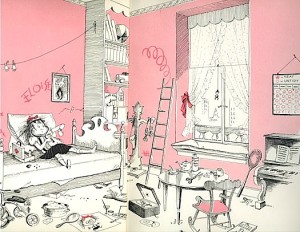 But unlike the omission of the Alice sequel, I had and have no problem with my delayed introduction to Eloise. You don’t need to be a grown-up to fully apprehend (the apprehension comes before the appreciation) Eloise, but it helps. I was already a noisy brat with an acutely developed aesthetic sense (along with some capacity for make-believe), so I didn’t need any encouragement in that direction. But what Eloise would have drawn out distinctly for me, in a way that I wouldn’t be aware of for at least a few precious years, was a certain class distinction that would have shut down my childhood and a certain part of my imagination a few years too soon. I could already imagine living at the Plaza – that was easily encompassed by my childhood imagination. But my parents weren’t the kind that hopped back and forth across the Atlantic; and as soon as I grasped the implications of “and charge it please,” the details of lawyers, hotel executives and “AT&T stock,” I would have realized that this world was hopelessly closed off to me (to say nothing of many of my suburban New Jersey neighbors and the world at large); and … let’s just say I would have been well on my way to ‘catching up’ with my brother’s ‘Rye-eyed’ jaundice.
But unlike the omission of the Alice sequel, I had and have no problem with my delayed introduction to Eloise. You don’t need to be a grown-up to fully apprehend (the apprehension comes before the appreciation) Eloise, but it helps. I was already a noisy brat with an acutely developed aesthetic sense (along with some capacity for make-believe), so I didn’t need any encouragement in that direction. But what Eloise would have drawn out distinctly for me, in a way that I wouldn’t be aware of for at least a few precious years, was a certain class distinction that would have shut down my childhood and a certain part of my imagination a few years too soon. I could already imagine living at the Plaza – that was easily encompassed by my childhood imagination. But my parents weren’t the kind that hopped back and forth across the Atlantic; and as soon as I grasped the implications of “and charge it please,” the details of lawyers, hotel executives and “AT&T stock,” I would have realized that this world was hopelessly closed off to me (to say nothing of many of my suburban New Jersey neighbors and the world at large); and … let’s just say I would have been well on my way to ‘catching up’ with my brother’s ‘Rye-eyed’ jaundice.
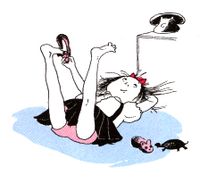 I already had some vague notion of socioeconomic class distinctions; knew that some of our relatives were somewhat ‘richer’ (and that their generosity made some of my early cultural experiences possible). But until I was ten or so, social ‘class’ was something infinitely mutable and flexible; something that was accessed principally by style, or some combination of style and achievement – and sheer imagination. Maria Callas, Leonard Bernstein, Chita Rivera, Jerome Robbins, Richard Burton, Mary Martin, Julie Andrews, Vladimir Horowitz; or the fancy people tripping through the Plaza Hotel, dressed in their Balenciaga and Balmain or Bill Blass and Donald Brooks – it was all the same world to me; and to think so much of it was happening right across the river. It was an enchanting escape for a kid who already knew she was, uh, ‘different.’ The disillusionment of the social/economic realities of credit charge cards, and the securities portfolios behind them, that were the underpinnings of Eloise’s life at the “tippy-top” of the Plaza Hotel could wait. That would have just made me want to “sklonk” someone in the kneecap. In the meantime, our needs could be satisfied by a hotel right around the corner (the St. Moritz) – where the milk shakes and root beer floats at Rumpelmayer’s were unsurpassed.
I already had some vague notion of socioeconomic class distinctions; knew that some of our relatives were somewhat ‘richer’ (and that their generosity made some of my early cultural experiences possible). But until I was ten or so, social ‘class’ was something infinitely mutable and flexible; something that was accessed principally by style, or some combination of style and achievement – and sheer imagination. Maria Callas, Leonard Bernstein, Chita Rivera, Jerome Robbins, Richard Burton, Mary Martin, Julie Andrews, Vladimir Horowitz; or the fancy people tripping through the Plaza Hotel, dressed in their Balenciaga and Balmain or Bill Blass and Donald Brooks – it was all the same world to me; and to think so much of it was happening right across the river. It was an enchanting escape for a kid who already knew she was, uh, ‘different.’ The disillusionment of the social/economic realities of credit charge cards, and the securities portfolios behind them, that were the underpinnings of Eloise’s life at the “tippy-top” of the Plaza Hotel could wait. That would have just made me want to “sklonk” someone in the kneecap. In the meantime, our needs could be satisfied by a hotel right around the corner (the St. Moritz) – where the milk shakes and root beer floats at Rumpelmayer’s were unsurpassed.
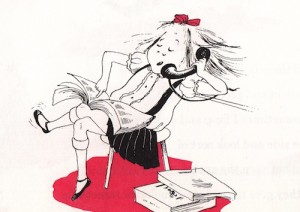 The other thing about Eloise – again suggested by the original subtitle – is that this is the expression of an adult giving voice to her inner six year-old. Eloise was actually a voice before she was a book, or even a developed ‘character.’ The story is that Kay Thompson, who wrote the text for the books, was late for a recording session or rehearsal date (in conjunction with her singing/performance career); and upon being scolded by some of the musicians and/or the producer on the date, spontaneously began channelling (in that trademark tiny, scratchy voice) the inner six year-old she called Eloise. “I am Eloise; I am six years old.” The real-life Kay Thompson had (until then) rarely given vent to such impishness. She was a consummate Hollywood professional with a distinguished career both in front of and behind the cameras. As her Hollywood and performance career flagged, though, she was looking for other outlets; and it was that other stylish New Yorker, D.D. Ryan (then an editor at Harper’s Bazaar), who connected her with Hilary Knight. The rest, as they say, is history.
The other thing about Eloise – again suggested by the original subtitle – is that this is the expression of an adult giving voice to her inner six year-old. Eloise was actually a voice before she was a book, or even a developed ‘character.’ The story is that Kay Thompson, who wrote the text for the books, was late for a recording session or rehearsal date (in conjunction with her singing/performance career); and upon being scolded by some of the musicians and/or the producer on the date, spontaneously began channelling (in that trademark tiny, scratchy voice) the inner six year-old she called Eloise. “I am Eloise; I am six years old.” The real-life Kay Thompson had (until then) rarely given vent to such impishness. She was a consummate Hollywood professional with a distinguished career both in front of and behind the cameras. As her Hollywood and performance career flagged, though, she was looking for other outlets; and it was that other stylish New Yorker, D.D. Ryan (then an editor at Harper’s Bazaar), who connected her with Hilary Knight. The rest, as they say, is history.
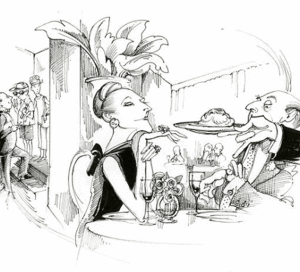 The flip side of that ‘inner six year-old’ is that it’s also not infrequently the voice of a willful, neurotic, selfish, co-dependent, substance-abusing/intolerant, and imbalanced (and/or undisciplined) adult. Speaking as one of those permanent six year-olds, this does not always make for merriment.
The flip side of that ‘inner six year-old’ is that it’s also not infrequently the voice of a willful, neurotic, selfish, co-dependent, substance-abusing/intolerant, and imbalanced (and/or undisciplined) adult. Speaking as one of those permanent six year-olds, this does not always make for merriment.
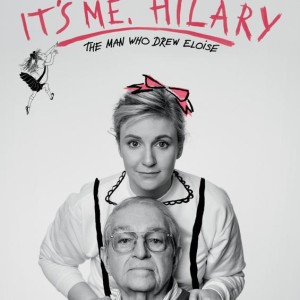 Which brings us to this evening’s HBO documentary, It’s Me, Hilary: The Man Who Drew Eloise, produced by Lena Dunham and Girls’ producer Jenni Konner and directed by Matt Wolf. I’m sure it will be reasonably entertaining; and I’m planning on watching it with my sister (who puts up with a good deal of my adult Eloise-hood, while having been fortunate enough to have missed the actual Eloise years of my life). But part of me chafes at Dunham’s seeming appropriation of the character (and I confess to some jealousy of her adoption of Hilary Knight, whose work I’ve long admired, not just as the creator of Eloise, but as a great illustrator). Here’s the thing: I don’t think Lena Dunham is old enough to appreciate that inner voice of Eloise. I don’t mean that generationally. I mean that I’m not sure I find it credible that Dunham had access to that particular Skipperdee-Weenie-doll-bleeding-knee-sklonking-ballroom-haunting-closet-sklanking sensibility at age 6, or the abject-arrogant-stage-fright-flight-aggressive-regressive-yes-I-drank-too-much loneliness of 6×5(x2) that gives voice (and bite) to it. I haven’t seen any reviews yet (though I see that The New York Times put one up sometime this morning), so I’ll withhold judgment. But oh my lord I don’t know how they’re going to bring back that voice and viewpoint. I’ll settle for Hilary Knight’s.
Which brings us to this evening’s HBO documentary, It’s Me, Hilary: The Man Who Drew Eloise, produced by Lena Dunham and Girls’ producer Jenni Konner and directed by Matt Wolf. I’m sure it will be reasonably entertaining; and I’m planning on watching it with my sister (who puts up with a good deal of my adult Eloise-hood, while having been fortunate enough to have missed the actual Eloise years of my life). But part of me chafes at Dunham’s seeming appropriation of the character (and I confess to some jealousy of her adoption of Hilary Knight, whose work I’ve long admired, not just as the creator of Eloise, but as a great illustrator). Here’s the thing: I don’t think Lena Dunham is old enough to appreciate that inner voice of Eloise. I don’t mean that generationally. I mean that I’m not sure I find it credible that Dunham had access to that particular Skipperdee-Weenie-doll-bleeding-knee-sklonking-ballroom-haunting-closet-sklanking sensibility at age 6, or the abject-arrogant-stage-fright-flight-aggressive-regressive-yes-I-drank-too-much loneliness of 6×5(x2) that gives voice (and bite) to it. I haven’t seen any reviews yet (though I see that The New York Times put one up sometime this morning), so I’ll withhold judgment. But oh my lord I don’t know how they’re going to bring back that voice and viewpoint. I’ll settle for Hilary Knight’s.
In the meantime, I know where Skiperdee is living. (He lives in and around a fountain at my former psychologist’s house/office.) I’m still looking for a proper Nanny. (It’s okay if you still smoke.) I am a city child and I miss New York. I am Ezrha Jean; I am six years old.

